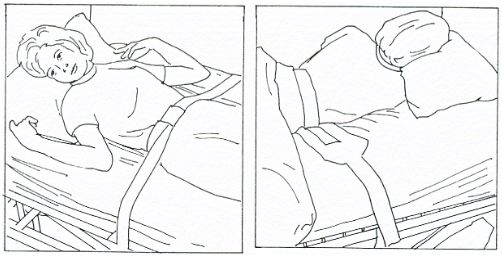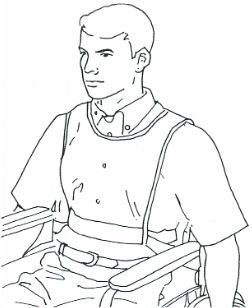|
6-1. INTRODUCTION
One of the most important aspects of patient care is to
ensure safety for each patient throughout the day. It is impossible to
prevent accidents completely. However, there are ways to limit the potential
for accidents that may cause injury to the patient or health care personnel
and the unnecessary loss of equipment.
6-2. HOSPITAL
ELECTRICAL SAFETY MEASURES
-
Use electrical equipment for the intended purpose only.
-
Keep television sets, telephones, radios, hair dryers,
electric shavers, and all other electrical equipment and appliances away
from bathtubs and washbasins.
-
Test all small appliances before use to see that they are
in good working order. Ensure periodic service checks of all electrical
equipment.
-
Remove a plug from a wall socket by grasping the plug, not
the cord.
-
Use plugs and outlets with a ground when possible. Do not
overload an electrical outlet.
-
Do not kink electric cords; this may cause the fine wires
inside the cord to break.
-
Never use faulty equipment. If an appliance overheats,
produces a shock or gives off an odor while being used, remove the
appliance from the area. Follow procedures to have the appliance evaluated
by medical maintenance. NOTE:
An electric spark near a high concentration of oxygen
or certain anesthetic gases may cause an instant and serious fire.
6-3. HOSPITAL FIRE
SAFETY MEASURES
-
Despite the use of fire retardant material, and compliance
with fire regulations, fires still occur. Health care facilities should
have regular fire drills so that all personnel know exactly what to do.
Health care personnel should be trained and drilled in:
-
Fire prevention.
-
Location and use of fire alarms.
-
Location and use of fire extinguishers.
-
Location of emergency exits.
-
Evacuation procedures.
-
Oxygen supports combustion. Post signs to show that oxygen
is in use where applicable. If a patient is receiving oxygen as part of
his treatment, be sure that the patient, his roommates, and visitors know
that smoking is prohibited. NOTE:
Smoking is prohibited in treatment areas of most health care facilities.
-
If a fire occurs, follow these steps:
-
Activate the fire alarm procedures.
-
Turn off oxygen, lights, and any electrical equipment in
the vicinity of the fire.
-
Remove the patients who are in immediate danger.
-
Notify the hospital "switchboard" of the location of the
fire.
-
Close windows and doors to reduce ventilation.
-
Using the fire extinguisher, attempt to extinguish the
fire.
-
Return patients who are not endangered to their rooms.
-
Post a guard to direct the fire department.
6-4.
PATIENT CARE ENVIRONMENT SAFETY MEASURES
-
Identify patients at risk for injury. Those at special
risk include:
-
Elderly or confused patients.
-
Patients with impaired vision or hearing.
-
Patients with impaired mobility (wheelchairs, walkers,
and partial paralysis).
-
Patients with a history of falls.
-
Patients with a history of substance abuse.
-
Patients receiving medication that interferes with
reasoning or motor functions.
-
Protect the patients at risk for injury.
-
To prevent falls:
-
Place the bed in the low position.
-
Keep the side rails up when the patient is not receiving
bedside care.
-
Advise the patient to wear low-heeled shoes that fit
well when walking.
-
Ensure that nonskid strips or mats are affixed to the
bottom of bathtubs and shower floors.
-
Ensure that bathtubs have sturdy handrails and shower
stools are in place when needed.
-
Warn patients and visitors when floors are wet and
slippery. Also see that signs are posted.
-
Protective restraints (see
figures 6-1 through
6-3).
-
Use restraints when careful assessment indicates that
these are needed. (Some facilities require a doctor's order for
restraints).
-
Movement is essential to the patient's well being. Use
the least restrictive type of restraint, which will protect the patient.
-
Apply the restraint for the shortest amount of time
necessary. The vest restraint (figure
6-2) may only be necessary while a patient is sitting in a
wheelchair.
-
Provide for as much movement as possible. The waist
restraint (figure 6-3)
protects the patient from falling out of bed but still allows the
patient to change position independently.
-
Restrain the fewest limbs or body parts possible.
However, if leg restraints are necessary, use wrist restraints also. If
this is not done, the patient may remove the leg restraints or he may
accidentally hang by his heels in the restraints.

Figure 6-3. Waist restraint.
-
Tie the restraint with a knot that is not likely to come
loose, yet can be released easily by the nurse in an emergency. A
half-bow knot (figure 6-4) meets
these criteria.
-
Explain to the patient the reason for the restraint.
Position him comfortably and change his position every 2 hours. Feed the
patient who must remain restrained during meals. Help him use the
toilet, bedpan, or urinal at regular intervals.
-
Prevent scalds and burns.
-
Place coffee, tea, and other hot liquids where the
patient can reach them easily and safely.
-
Assist the patient if there is any doubt about whether
he can safely regulate the temperature of water in tubs or showers.
-
Carefully follow policy when using hot-water bags or
heating pads. Because of the danger of burning patients, many health
care facilities do not allow their use.
-
Prevent the spread of infection. A health care facility
may adopt its own infection control policies and practices. However, the
procedures generally follow the recommendations from the Centers for
Disease Control (CDC). This is a federal agency that studies pathogens,
outbreaks of contagious diseases, and methods used to control these
outbreaks.
-
Preventing disease, including infections, is a high
priority in health care. Nurses should use techniques that prevent
microorganisms from living, growing, and spreading.
-
Two methods are used to reduce or eliminate the presence
of microorganisms and thus prevent infections. These two methods are
called surgical asepsis and medical asepsis.
-
Surgical asepsis refers to the practice that
eliminates the presence of all microorganisms (bacteria, viruses,
fungi, yeasts, molds, rickettsia, and protozoa). This practice is
sterilization.
-
Medical asepsis refers to practices that help reduce
the number and inhibit the growth of microorganisms, especially
pathogens (those that cause infections or contagious diseases).
Medical asepsis, also called clean technique includes use of
antimicrobial agents, hand washing, cleaning supplies and equipment,
and disinfection.
-
Infections and infectious diseases begin in a reservoir
and move full circle to a susceptible host (see
figure 6-5).
-
Reservoir. This is the place on which or in which
organisms grow and reproduce. Examples include man and animals.
-
Exit from reservoir. Escape routes for organisms
include the nose, throat, mouth, ear, eye, intestinal tract, urinary
tract, and wounds.
-
Vehicle of transmission. The means by which organisms
are carried about include hands, equipment, instruments, china and
silverware, linens, and droplets.
-
Portal of entry. The part of the body where organisms
enter include any break in skin or mucous membrane, the mouth, nose,
and genitourinary tract.
-
Susceptible host. A person who cannot fight off the
organism once it enters his body and therefore, he becomes ill.
-
Report infections. Health care workers must report any
infection that occurs. The Infection Control Committee will investigate
any case of infection to determine the cause. If a break in nursing
technique is identified, the committee will propose different procedures
to eliminate the problem.
6-5. CLOSING
Maslow states that our safety and security needs are second
only to the need for food, air, and water. The daily responsibility for
protecting the patient from additional injury or illness rests with the
nursing team. The skillful and knowledgeable nurse can be just as dangerous
as the incompetent one if safety measures are not applied in the health care
environment.
Continue with Exercises
The Brookside
Associates Medical Education Division is dedicated to the development and
dissemination of medical information that may be useful to medical professionals
and those in training to become medical professionals. This website is
privately-held and not connected to any governmental agency. The views expressed
here are those of the authors, and unless otherwise noted, do not necessarily
reflect the views of the Brookside Associates, Ltd., any governmental or private
organizations. All writings, discussions, and publications on this website are
unclassified.
© 2007 Medical Education
Division, Brookside Associates, Ltd. All rights reserved
Other
Brookside Products
Contact Us

Advertise on this Site
|
|





